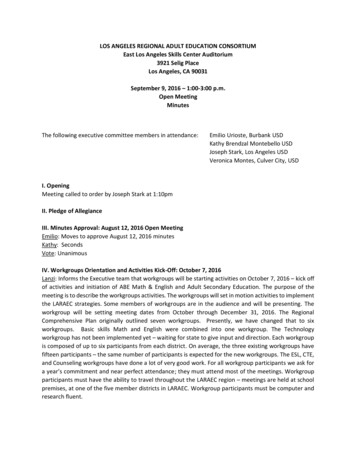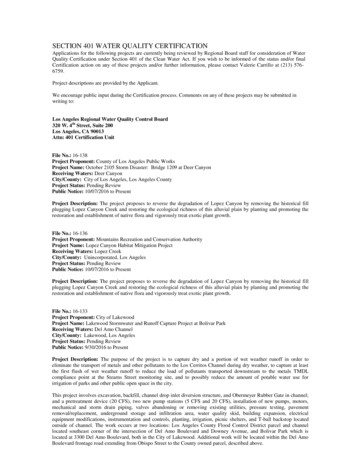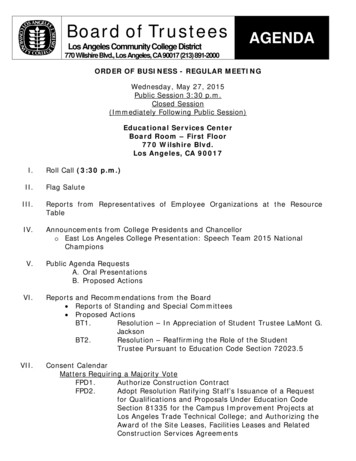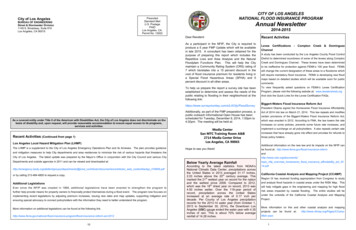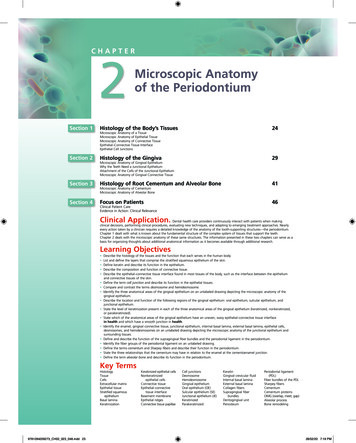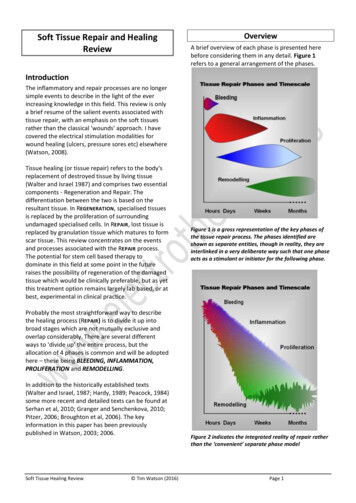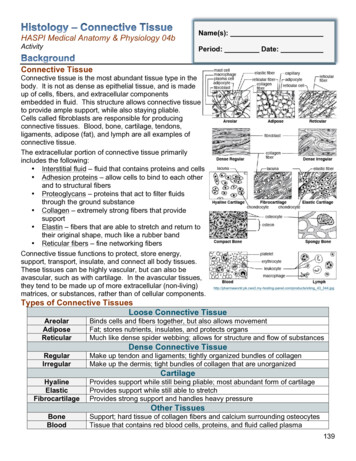
Transcription
Study of TissuesDr. A. Ebneshahidiebneshahidi
Tissues Tissues are composed of cells similar in structure and specializedto perform a specific function for the body. The human body is made of four general types of tissues.– Epithelial tissues – for lining body cavities, covering internalorgans and large surfaces.– Connective tissues – for supporting and linking tissues ororgans together; some are specialized to provide protection, tostore fat, and even to provide circulatory function in thecardiovascular system.– Muscle tissues – for providing contraction and relaxation inthe body surfaces, in the heart chambers , and in hollow organssuch as blood vessels and the digestive tract.– Nerve tissue – for generating and transmitting electricalsignals (nerve impulses ) in the brain, spinal cord, and nerves.ebneshahidi
Epithelial tissues (Epithelium) 1. Covering of body surfaces and internal organs, and lining ofbody cavities. 2. Major tissue component of glands. 3. Always has a free surface (exposed to an open space) and abasement membrane (usually anchored to a connective tissue). 4. Lacks blood vessels , so nourishment comes from the underlyingconnective tissue by diffusion movement. 5. Other unique characteristics: a. Reproduce rapidly. b. Cells in epithelial tissues are often attached to one another bydesmosomes which allow the tissue to serve as an excellentprotective layer.ebneshahidi
c. The name isderived from thenumber of layer ofcells ("simple" meansa single layer while"stratified " meansmultiple layers ) andthe shape of cells("squamous" meansflattened , "cuboidal"means cube – shaped,and "columnar"means elongated ).ebneshahidi
1. Simple squamous epithelium– a single layer of thin , flattened cells.– Found in areas where diffusion or filtration occurs.– Examples – air sacs of lungs , kidney tubules , and capillary wall.– Simple squamous epithelium lining blood vessels and heart iscalled endothelium.ebneshahidi
2. Simple cuboidal epithelium– a single layer of cube – shaped cells .– Found in areas where secretion or absorption occurs.– Examples – kidney tubules, and ducts of glandsebneshahidi
3. Simple columnar epithelium– a single layer of elongated cells.– designed for protection, secretion, or absorption.– examples – lining of uterus and small intestine.– some columnar cells have finger – like projections calledmicrovilli which are extension of the cell membrane forincreasing the surface area in absorption.ebneshahidi
4. Pseudostratified columnar epithelium a single layer of columnar cells that appears to be multiple – layeredbecause of its multiple – layered nuclei . the cells have hair – like protein structure called cilia on the cellmembrane to trap and expel foreign particles or bacteria, or they maybe used to propel the egg cell in the uterine tubes.ebneshahidi
5. Stratified squamous epithelium many layers of flattened cells . cells at the bottom layers are the youngest and cuboidal – shaped, andwill become flattened as they move upward to higher layers. Forms the epidermis (top skin layer), lining of oral cavity, throat, andvagina.ebneshahidi
6. Stratified cuboidal epithelium 2-3 layers , cube shaped cells. Function: protection. Location : lining of larger ducts of sweat glands , salivarygourds and the pancreas.7. Stratified columnar epithelium Top layer of elongated cells lower layers of cube-shaped cells . Location : use deferens , port of the urethra and pharynx. Function : protection, secretion.ebneshahidi
7. Transitional Epithelium many layers of cube – shaped and elongated cells function : Dispensability, protection location : inner lining of urinary bladder and lining of waters andurethra .ebneshahidi
8. Glandular epithelium– specialized to produce and secrete chemicalsubstances into ducts or body fluids .– made of cuboidal or columnar cells.– Exocrine glands use ducts to secrete theirproducts into an open space (e.g. sweat glands ,oil glands , salivary glands, and tear glands).– Endocrine glands secrete their products(hormones) directly into blood or body fluids (e.g.all hormonal glands are endocrine glands).ebneshahidi
Types of exocrine glands Merocrine glands – A fluid product releasedthrough the cell membrane by exocytosis . ex:salivary glands , pancreatic glands , sweatglands. Aporcine glands – cellular product andportions of the free ends of cells pinch offduring secretion. ex : mammary glands . Holocrine glands – Entire cell with secretoryproducts rupture Ex : sebaceous glands of skin.ebneshahidi
Merocrine and Holocrine glandebneshahidi
Multicellular exocrine glands Simple – single unbranched duct Compound – branched duct Multicellular exocrine glands can be:a) Tubular – secretory cells form a tube.b) Alveolar – secretory cells form a sac.c) tubuloalveolarebneshahidi
ebneshahidi
Unicellular Exocrine Glands Unicellular exocrine glands;Single cellsHave no ductsProduce mucin: forms mucus that protect andlubricate surfaces.ebneshahidi
Connective tissue Most abundant of the primary tissues by weight. Function :1) Binding and Support2) Protection3) Insulation4) Transportation (blood) origin : All C.T. arise from mesenchyme derived from embryonicmesoderm germ layer. Have matrix : fills the space between cells. Fibers ( 3 types). ground substance (matrix): fills the space between cells. cellsebneshahidi
Connective Tissueebneshahidi
Contain a noncellular matrix which is made of protein fibers andground substances . Contain "resident cells" and “wandering cells” Fibers of connective tissue:1. Collagen fibers – provide tensile strength (thickest fibers).2. Elastic fibers – provide stretch.3. Reticular fibers – provide a network to support blood vessels andsupport soft tissue of organs. Cells of connective tissue :1. Fibroblast – form connective tissue proper.2. Chondroblast - cartilage forming.3. Osteoblast – bone forming.4. Hemocytoblast – blood forming.ebneshahidi
Major classes of connective tissueebneshahidi
Other cells in connective tissue :1. White blood cells (immunity)2. Plasma cells (antibody producing)3. Mast cells (detect bacteria and fungi andinitiate local inflammatory -responseagainst them)3. Macrophages (immunity) – engulf anddispose bacteria , and other un wantedsubstances .ebneshahidi
Loose Connective Tissue Loose connective tissue:(areola connective tissue) Forms delicate , thinmembranes throughout thebody. Binds the skin tounderlying organs , fillsspaces between musclesand other organs . Consists of cells calledfibroblasts , and bothcollagen us and elasticfibers in the matrix.ebneshahidi
Reticular Connective Tissue: resembles loose areolar C.T. Butonly has reticular fibers.ebneshahidi
Adipose TissueModified from looseconnective.Specialized to store fatat the center of ring –shaped cells calledadipocytes.Serves as protectivecushion for joints andorgans , as heatinsulator beneath theskin , and to storeenergy .ebneshahidi
Dense Regular Connective Tissue Dense regularconnective tissue: forms tendons, andligaments. Poor blood supply. Contains closelypacked bundles ofcollagen fibers .ebneshahidi
Dense irregular Connective tissue– Arranged irregularly.– Bundles are much thicker.– Forms Dermis (inner skin layer).ebneshahidi
Blood Blood: most atypicalconnective tissue. it iscomposed of cells thatare suspended in afluid intercellularmatrix called bloodplasma.ebneshahidi
Cartilage Support body parts , provide frameworks andattachments , protect underlying tissues, and form amodel for developing bones. Contain a rich matrix made of protein fibers andprotein – rich ground substances. Consist of cells called chondrocytes which arefound in cavities called lacunae. The cells obtaintheir nutrients by diffusion from the matrix, sincecartilage is the only C.T. that is avascular.ebneshahidi
Hyaline cartilage Hyaline cartilage contains fine collagenus fibers in the matrix. The most commontype of cartilage. Found in the ends ofbones at the joints ,and surrounding thetrachea.ebneshahidi
Elastic Cartilage Contains elasticfibers in the matrix. Provides frameworkfor the external earand the larynx.ebneshahidi
Fibrocartilage contains thickcollagen us fibers inthe matrix. Serves as shockabsorber in the intervertebral disks, andbetween bones in theknee and pelvis.ebneshahidi
Bone Bone tissue (or osseous tissue): The most rigid connective tissue because of the calciumdeposited in the matrix. Provides internal support for the body, protects vitalorgans , and serves as attachment for most skeletalmuscles. Consists of many functional units called ostenos . Eachosteen is composed of cells called osteocytes (surroundedby lacunae) forming concentric circles around theosteonic canal. Blood vessels in the isotonic canal allow nutrients todiffuse into fine channels called canaliculi fordistributing the nourishment to all osteocytes .ebneshahidi
Boneebneshahidi
Muscle tissue Consist of muscle cells called muscle fiberswhich contain long protein filaments calledmyofibrils that allow the cells to contract andproduce body movements . Function: movement Location: attached to bones in the walls ofhollow internal organs Characteristics: contractile Types: 3 typesebneshahidi
Skeletal Muscle Skeletal muscle (striated muscle) under voluntary control , multinucleated, striated, and cancontract with powerful force.ebneshahidi
Cardiac Muscle mostly under involuntary control, uninucleated, cross-striated,form interconnected branching, contain specialized intercellularjunctions called intercalated disk, and can contract continuouslyand rapidly .ebneshahidi
Smooth muscle Smooth muscle (or involuntary, visceral muscle) under involuntary control, uninucleated, not striated, andcontracts with less force but longer duration.ebneshahidi
Nervous Tissue found in the brain , spinal cord , and nerves. consists of cells called neurons that aresensitive to changes (stimuli) in theenvironment and within the body , resulting ingenerating and transmitting nerve impulsesthrough their nerve fibers. 2 types of nerve fibers axon – only 1 per neuron ; transmits impulsesaway from the cell. Dendrite – thousands per neuron ; transmitsimpulses to the cell.ebneshahidi
Nervous Tissueebneshahidi
Epithelial membranes It is a continuous multicellular sheet composed of at least 2layer epithelium underlying layer of connective tissue 1. Cutaneous membranes:The coetaneous membrane is the skin which has :keratinized squamous epithelium known as epidermis.underlying layer of dense irregulars connective tissue ordermis.ebneshahidi
Mucous membranes:line body cavityunderlying layer of loose connective tissue called lamina propria.ebneshahidi
serous membranes: moist membrane found in ventral body cavity. it has aparietal layer that lines the cavity wall and a viscerallayer that covers the outer surface of organs within thecavity . Between the above layers is a thin clear serous fluid thatact as a lubricant . The serous lining the thoracic cavity and covering lung isthe pleura . The serous enclosing the heart is the pericardium . The serous enclosing the abdomen pelvic cavity andviscera are the peritoneums.ebneshahidi
ebneshahidi
synovial membrane– forms inner lining of joint cavities at the synovialjoints (freely movable joints)– made of a layer of cuboidal epithelium over a layerof connective tissue .– secretes synovial fluid to lubricate the synovialjoints .ebneshahidi
Developmental aspects of tissue There are 3 primary germ cell embryonically.1) Ectoderm2) Mesoderm3) EndodermThese germ cells specialize to form the 4 primary tissues fromwhich all body organs are derived .Epithelial tissues are formed by all 3 germ layers .Mucosal epithelium is from endodermEndothelium isfrom mesodermEpidermis is from ectodermMuscle and connective tissue are derived from mesodermnervous tissue is form ectodermebneshahidi
Embryonic germ layersebneshahidi
Clinical Terms Adenoma: tumor of glandular Epithelium. Carcinoma: cancer arising in an epithelium. Sarcoma: cancer arising from mesenchyme –derived tissue, that is in connective tissue andmuscle. Lesion: an injury or wound. Pathology: study of changes in organ andtissues produced by disease.ebneshahidi
3. Always has a free surface (exposed to an open space) and a basement membrane (usually anchored to a connective tissue). 4. Lacks blood vessels , so nourishment comes from the underlying connective tissue by diffusion movement. 5. Other unique characteristics: a. Reproduce rapidly. b.
